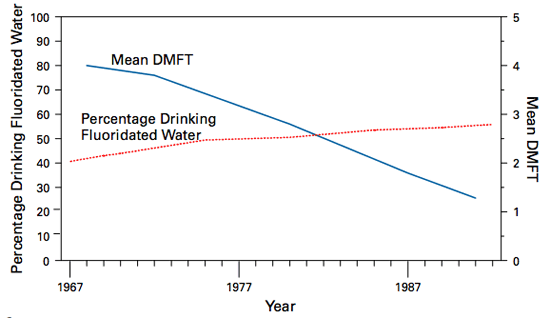Fluoride advocates often claim that the reduction in tooth decay that has occurred since the 1950s is the result of the widespread introduction of fluoridated water. In 1999, for example, the Centers for Disease Control stated that “as a result [of water fluoridation], dental caries declined precipitously during the second half of the 20th century.” As support for this assertion, the CDC published the following figure:

SOURCE: Centers for Disease Control (1999). Achievements in Public Health, 1900-1999: Fluoridation of Drinking Water to Prevent Dental Caries. MMWR 48:933-40.
What the CDC failed to mention is that tooth decay rates have “precipitously declined” in all western countries, irrespective of whether the country ever fluoridated its water. Indeed, most western countries do not fluoridate their water and yet their tooth decay rates have declined at the same rate as the U.S. and other fluoridated countries. This fact, which is widely acknowledged in the dental literature (see below), can be quickly demonstrated by examining the World Health Organization’s (WHO) data on tooth decay trends in each country. The following two figures and table, for example, compare the tooth decay trends in western countries with, and without, water (or salt) fluoridation.
| DMFT (Decayed, Missing & Filled teeth) Status for 12 year olds by Country – World Health Organization Data (2012) – |
|||
| Country | DMFTs | Year | Status* |
| Denmark | 0.7 | 2008 | No water fluoridation. No salt fluoridation. |
| Germany | 0.7 | 2005 | No water fluoridation. 67% salt fluoridation. |
| England | 0.7 | 2009 | 11% water fluoridation. No salt fluoridation. |
| Netherlands* | 0.8 | 2002 | No water fluoridation. No salt fluoridation. |
| Switzerland** | 0.82 | 2009 | No water fluoridation. 88% salt fluoridation. |
| Belgium | 0.9 | 2009-10 | No water fluoridation. No salt fluoridation. |
| Sweden | 0.9 | 2008 | No water fluoridation. No salt fluoridation. |
| Australia | 1.0 | 2003-2004 | 80% water fluoridation. No salt fluoridation. |
| Austria | 1.0 | 2002 |
No water fluoridation.
6% salt fluoridation.
|
| Ireland | 1.1 | 2002 | 100% water fluoridation in study. No salt fluoridation. |
| Italy | 1.1 | 2004 | No water fluoridation. No salt fluoridation. |
| United States | 1.19 | 1999-2004 | 64% water fluoridation. No salt fluoridation. |
| Finland | 1.2 | 2006 | No water fluoridation. No salt fluoridation. |
| France | 1.2 | 2006 | No water fluoridation. 65% salt fluoridation. |
| Spain | 1.3 | 2004 | 11% water fluoridation. 10% salt fluoridation. |
| Greece | 1.35 | 2005-06 | No water fluoridation. No salt fluoridation. |
| Iceland | 1.4 | 2005 | No water fluoridation. No salt fluoridation. |
| New Zealand | 1.4 | 2009 | 61% water fluoridation. No salt fluoridation. |
| Japan | 1.7 | 2005 | No water fluoridation. No salt fluoridation. |
| Norway | 1.7 | 2004 | No water fluoridation. No salt fluoridation. |
| * The Hague | ** Zurich | |||
Tooth Decay data from:
Salt fluoridation data from:
|
|||
Published Research and Commentary on the Decline in Tooth Decay in the Western World:
“Although the prevalence of caries varies between countries, levels everywhere have fallen greatly in the past three decades, and national rates of caries are now universally low. This trend has occurred regardless of the concentration of fluoride in water or the use of fluoridated salt, and it probably reflects use of fluoridated toothpastes and other factors, including perhaps aspects of nutrition.”
SOURCE: Cheng KK, et al. (2007). Adding fluoride to water supplies. British Medical Journal 335(7622):699-702.
“In most European countries, where community water fluoridation has never been adopted, a substantial decline in caries prevalence has been reported in the last decades, with reductions in lifetime caries experience exceeding 75%.”
SOURCE: Pizzo G, et al. (2007). Community water fluoridation and caries prevention: a critical review. Clinical Oral Investigations 11(3):189-93.
“Graphs of tooth decay trends for 12 year olds in 24 countries, prepared using the most recent World Health Organization data, show that the decline in dental decay in recent decades has been comparable in 16 nonfluoridated countries and 8 fluoridated countries which met the inclusion criteria of having (i) a mean annual per capita income in the year 2000 of US$10,000 or more, (ii) a population in the year 2000 of greater than 3 million, and (iii) suitable WHO caries data available. The WHO data do not support fluoridation as being a reason for the decline in dental decay in 12 year olds that has been occurring in recent decades.”
SOURCE: Neurath C. (2005). Tooth decay trends for 12 year olds in nonfluoridated and fluoridated countries. Fluoride 38:324-325.
“It is remarkable… that the dramatic decline in dental caries which we have witnessed in many different parts of the world has occurred without the dental profession being fully able to explain the relative role of fluoride in this intriguing process. It is a common belief that the wide distribution of fluoride from toothpastes may be a major explanation, but serious attempts to assess the role of fluoridated toothpastes have been able to attribute, at best, about 40-50% of the caries reduction to these fluoride products. This is not surprising, if one takes into account the fact that dental caries is not the result of fluoride deficiency.”
SOURCE: Aoba T, Fejerskov O. (2002). Dental fluorosis: chemistry and biology. Critical Review of Oral Biology and Medicine 13: 155-70.
“A very marked decline in caries prevalence [in Europe] was seen in children and adolescents…The number of edentulous adults in Europe has also been declining considerably.”
SOURCE: Reich E. (2001). Trends in caries and periodontal health epidemiology in Europe. International Dentistry Journal 51(6 Suppl 1):392-8.
“The caries attack rate in industrialized countries, including the United States and Canada, has decreased dramatically over the past 40 years.”
SOURCE: Fomon SJ, Ekstrand J, Ziegler EE. (2000). Fluoride intake and prevalence of dental fluorosis: trends in fluoride intake with special attention to infants. Journal of Public Health Dentistry 60: 131-9.
“Since the 1960s and 70s, however, a continuous reduction (in tooth decay) has taken place in most ‘westernized’ countries, it is no longer unusual to be caries-free… During the decades of caries decline, a number of actions have been taken to control the disease, and the literature describes numerous studies where one or several factors have been evaluated for their impact. Still, it is difficult to get a full picture of what has happened, as the background is so complex and because so many factors may have been involved both directly and indirectly. In fact, no single experimental study has addressed the issue of the relative impact of all possible factors, and it is unlikely that such a study can ever be performed.”
SOURCE: Bratthall D, Hansel-Petersson G, Sundberg H. (1996). Reasons for the caries decline: what do the experts believe? European Journal of Oral Science 104:416-22.
“Caries prevalence data from recent studies in all European countries showed a general trend towards a further decline for children and adolescents…The available data on the use of toothbrushes, fluorides and other pertinent items provided few clues as to the causes of the decline in caries prevalence.”
SOURCE: Marthaler TM, O’Mullane DM, Vrbic V. (1996). The prevalence of dental caries in Europe 1990-1995. ORCA Saturday afternoon symposium 1995. Caries Research 30: 237-55
“The aim of this paper is to review publications discussing the declining prevalence of dental caries in the industrialized countries during the past decades…[T]here is a general agreement that a marked reduction in caries prevalence has occurred among children in most of the developed countries in recent decades.”
SOURCE: Petersson GH, Bratthall D. (1996). The caries decline: a review of reviews. European Journal of Oral Science 104: 436-43.
“The regular use of fluoridated toothpastes has been ascribed a major role in the observed decline in caries prevalence in industrialized countries during the last 20 to 25 years, but only indirect evidence supports this claim.”
SOURCE: Haugejorden O. (1996). Using the DMF gender difference to assess the “major” role of fluoride toothpastes in the caries decline in industrialized countries: a meta-analysis. Community Dentistry and Oral Epidemiology 24: 369-75.
“The marked caries reduction in many countries over the last two decades is thought to be mainly the result of the widespread and frequent use of fluoride-containing toothpaste… There seem to be no other factors which can explain the decline in dental caries, which has occurred worldwide during the same period, in geographic regions as far apart as the Scandinavian countries and Australia/New Zealand.”
SOURCE: Rolla G, Ekstrand J. (1996). Fluoride in Oral Fluids and Dental Plaque. In: Fejerskov O, Ekstrand J, Burt B, Eds. Fluoride in Dentistry, 2nd Edition. Munksgaard, Denmark. p 215.
“Although difficult to prove, it is reasonable to assume that a good part of the decline in dental caries over recent years in most industrialized countries, notably those Northern European countries without water fluoridation, can be explained by the widespread use of fluoride toothpastes. This reduction in caries has not been paralleled by a reduction in sugar intake…”
SOURCE: Clarkson BH, Fejerskov O, Ekstrand J, Burt BA. (1996). Rational Use of Fluoride in Caries Control. In: Fejerskov O, Ekstrand J, Burt B, Eds. Fluoride in Dentistry, 2nd Edition. Munksgaard, Denmark. p 354.
“During the past 40 years dental caries h as been declining in the US, as well as in most other developed nations of the world… The decline in dental caries has occurred both in fluoride and in fluoride-deficient communities, lending further credence to the notion that modes other than water fluoridation, especially dentrifices, have made a major contribution.”
SOURCE: Leverett DH. (1991). Appropriate uses of systemic fluoride: considerations for the ’90s. Journal of Public Health Dentistry 51: 42-7.
“In most European countries, the 12-year-old DMFT index is now relatively low as compared with figures from 1970-1974. WHO (World Health Organization) data relating to availability of fluoride in water and toothpaste appear reliable. However, these data did not explain differences between countries with respect to the DMFT index of 12-year-olds.”
SOURCE: Kalsbeek H, Verrips GH. (1990). Dental caries prevalence and the use of fluorides in different European countries. Journal of Dental Research 69(Spec Iss): 728-32.
“The most striking feature of some industrialized countries is a dramatic reduction of the prevalence of dental caries among school-aged children.”
SOURCE: Binus W, Lowinger K, Walther G. (1989). [Caries decline and changing pattern of dental therapy] [Article in German] Stomatol DDR 39: 322-6.
“The current reported decline in caries tooth decay in the US and other Western industrialized countries has been observed in both fluoridated and nonfluoridated communities, with percentage reductions in each community apparently about the same.”
SOURCE: Heifetz SB, et al. (1988). Prevalence of dental caries and dental fluorosis in areas with optimal and above-optimal water-fluoride concentrations: a 5-year follow-up survey. Journal of the American Dental Association 116: 490-5.
“[D]uring the period 1979-81, especially in western Europe where there is little fluoridation, a number of dental examinations were made and compared with surveys carried out a decade or so before. It soon became clear that large reductions in caries had been occurring in unfluoridated areas. The magnitudes of these reductions are generally comparable with those observed in fluoridated areas over similar periods of time.”
SOURCE: Diesendorf, D. (1986). The Mystery of Declining Tooth Decay. Nature 322: 125-129.
“Even the most cursory review of the dental literature since 1978 reveals a wealth of data documenting a secular, or long term, generalized decline in dental caries throughout the Western, industrialized world. Reports indicate that this decline has occurred in both fluoridated and fluoride-deficient areas, and in the presence and absence of organized preventive programs.”
SOURCE: Bohannan HM, et al. (1985). Effect of secular decline on the evaluation of preventive dentistry demonstrations. Journal of Public Health Dentistry 45: 83-89.
“The decline in caries prevalence in communities without fluoridated water in various countries is well documented. The cause or causes are, at this time, a matter of speculation.”
SOURCE: Leverett DH. (1982). Fluorides and the changing prevalence of dental caries. Science 217: 26-30.
Tooth Decay Trends in Specific European Countries:

BELGIUM – Unfluoridated Water, Fluoridated Salt:
“Caries-free children increased from 4% to 50%…A remarkable decline in dental caries was observed during the 15-yr period.”
SOURCEL Carvalho JC, Van Nieuwenhuysen JP, D’Hoore W. (2001). The decline in dental caries among Belgian children between 1983 and 1998. Community Dentistry and Oral Epidemiology 29: 55-61.

DENMARK – Unfluoridated Water, Unfluoridated Salt:
“The paper presents an overview of the oral health situation in Denmark…[N]ational oral epidemiological data have been provided since 1972. Partly due to the preventive approach, a general decrease over-time in the prevalence of dental caries has been documented for children and adolescents. For example, in 1972 children in first class had a mean caries experience of 12.4 def-s against 3.9 def-s in 1990.”
SOURCE: Petersen PE. (1992). Effectiveness of oral health care–some Danish experiences. Proceedings of the Finnish Dental Society 88: 13-23.

FINLAND – Unfluoridated Water, Unfluoridated Salt:
“During the 10 years, substantial decreases were seen in the mean numbers of dental visits (from 4.0 to 2.4) and fillings (from 2.9 to 1.2). The greatest decrease was seen in the number of fillings made in incisors.”
SOURCE: Vehkalahti M, Rytomaa I, Helminen S. (1991). Decline in dental caries and public oral health care of adolescents. Acta Odontologica Scandinavica 49: 323-8.

FRANCE – Unfluoridated Water, Fluoridated Salt:
“Epidemiological surveys showed a marked decrease of caries prevalence in French children during the last 20 years.”
SOURCE: Obry-Musset AM. (1998). [Epidemiology of dental caries in children] [Article in French] Arch Pediatr 5: 1145-8.

GERMANY – Unfluoridated Water, Fluoridated Salt:
“Caries rates are on the decline in the Federal Republic of Germany, too. And, in some cases considerable, increase in the number of children with caries-free teeth and a clear reduction in the average number of carious teeth has been recorded, above all in kindergartens with preventive dentistry programmes.”
SOURCE: Gulzow HJ. (1990). [Preventive dentistry in the Federal Republic of Germany] [Article in German] Oralprophylaxe 12: 53-60.

THE NETHERLANDS – Unfluoridated Water, Unfluoridated Salt:
“According to WHO criteria, 12-year-old children in The Netherlands now have a very low caries experience.”
SOURCE: Truin GJ, Konig KG, Bronkhorst EM. (1994). Caries prevalence in Belgium and The Netherlands. International Dentistry Journal 44: 379-8.

NORWAY & all SCANDINAVIAN COUNTRIES – Unfluoridated Water, Unfluoridated Salt:
“Denmark, Iceland, Norway, and Sweden have all had a similar decline in dental caries during the last 20 years, although the decline has come later in Iceland. Despite the differences in choice of preventive methods, the dental health of children varies little across the frontiers.”
SOURCE: Kallestal C, et al. (1999). Caries-preventive methods used for children and adolescents in Denmark, Iceland, Norway and Sweden. Community Dentistry and Oral Epidemiology 27: 144-51.
“Despite differences in the dental health care services and the recording and reporting systems, a consistent and similar decline in dental caries is evident for Denmark, Finland, Norway and Sweden during the last two decades.”
SOURCE: von der Fehr FR. (1994). Caries prevalence in the Nordic countries. International Dentistry Journal 44: 371-8.

SWEDEN – Unfluoridated Water, Unfluoridated Salt:
“Between 1967 and 1992 the mean dmfs values declined from 7.8 to 1.8. The decline was greatest between 1967 and 1980 and then levelled off.”
SOURCE: Stecksen-Blicks C, Holm AK. (1995). Dental caries, tooth trauma, malocclusion, fluoride usage, toothbrushing and dietary habits in 4-year-old Swedish children: changes between 1967 and 1992. International Journal of Paediatric Dentistry 5: 143-8
“During the last decade, a continuous decrease in dental caries has been observed among schoolchildren in Iceland…There does not seem to be any single factor responsible for the onset of the caries decline.”
SOURCE: Einarsdottir KG, Bratthall D. (1996). Restoring oral health: On the rise and fall of dental caries in Iceland. European Journal of Oral Science 104: 459-69.
GREECE – Unfluoridated Water, Unfluoridated Salt:
“The percentage of caries-free children for the total examined population increased by 94% while the reduction in DMFT index ranged between 38 and 70%. Treatment need was significantly lower in 1991 compared to 1982 in both dentitions.”
SOURCE: Athanassouli I, et al. (1994). Dental caries changes between 1982 and 1991 in children aged 6-12 in Athens, Greece. Caries Research 28(5):378-82.
SWITZERLAND – Unfluoridated Water, Fluoridated Salt:
“Caries prevalence has declined by 70-84 percent since the late sixties.”
SOURCE: Marthaler TM. (1991). [School dentistry in Zurich Canton: changes as a result of caries reduction of 80 to 85 percent] [Article in German] Oralprophylaxe 13: 115-22.
“Surveys of dental caries prevalence were carried out from 1970-1993 in schoolchildren of the city of Zurich. DMFT experience declined by 68 to 80%, while the average dmft decreased by 48-53% (ages 7 to 9).”
SOURCE: Steiner M, Menghini G, Curilovic Z, Marthaler T. (1994). [The caries occurrence in schoolchildren of the city of Zurich in 1970-1993. A view of prevention in new immigrants] [Article in German]. Schweiz Monatsschr Zahnmed 104: 1210-8.


